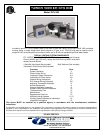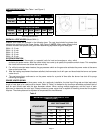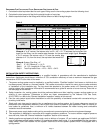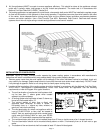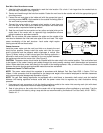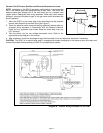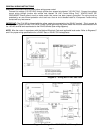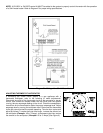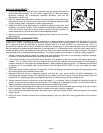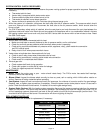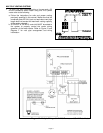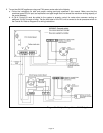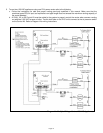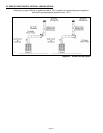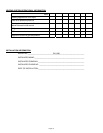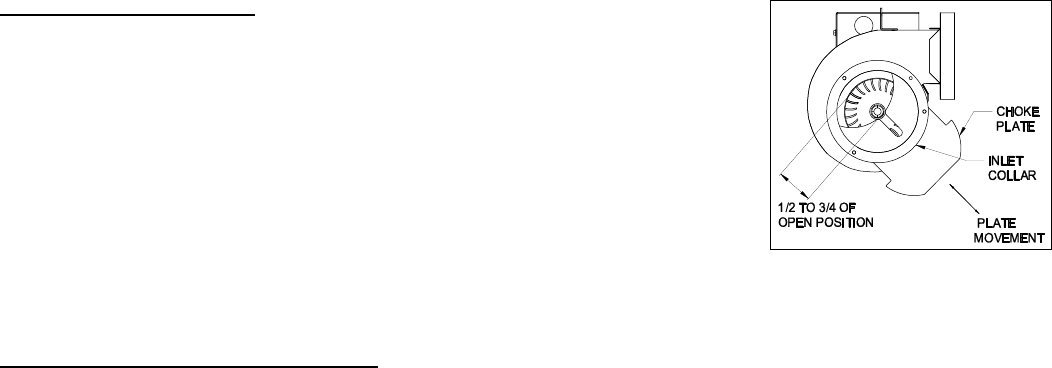
Page 9
AIR FLOW ADJUSTMENTS
1. To properly adjust the venter air flow, loosen the inlet ring screws and open the
choke plate approximately 1/2 to 3/4 open. (See Figure 9) Start the heating
appliance following the manufacturer specified procedure, and set the
thermostat to call for heat.
2. After the system has operated for several minutes to stabilize the exhaust gas
temperature, check for air flow at the draft hood or the heating appliance outlet
using a velocity meter, draft meter, or match test procedure.
3. Adjust the venter choke plate inward or outward to obtain the minimum draft
necessary to maintain venting. Then increase the draft slightly (Approximately
10% over minimum flow rate) to ensure proper venting during any variations in
venter performance, such as wind load or house depressurization.
4. Secure the choke plate into position by tightening the screws on the inlet collar
(See Figure 9)
GENERAL INSTALLATION INSPECTION
Follow recommended procedures for safety inspection of a heating appliance in accordance with the National Fuel Gas
Code A.N.S.I. Z223.1. The following procedure will help in evaluation of the venting system. It is intended as a guide to
aid in determining that the appliance is properly installed and is in a safe condition for continuous use. This is a
generalized procedure, which cannot anticipate all situations. Accordingly, in some cases deviation from this procedure
may be necessary to determine safe operation of the equipment. If it is determined that a condition which could result in
unsafe operation exists, the appliance should be shut off and the owner advised of the unsafe conditions. Corrections
must be made prior to allowing continuous operation. The following steps should be taken in making a safety inspection.
1. Visually inspect the venting system for proper size and determine that there is no blockage, restriction, leakage,
corrosion, or other deficiencies, which could cause unsafe operation.
2. To the extent possible, close all building doors, windows, and all doors to the room in which the heating appliance is
located. Turn on clothes dryers and any exhaust fans so that they operate at maximum speed. Do not operate a
summer exhaust fan. Also close all fireplace dampers. If after completing steps 3 through 7 it is believed that sufficient
combustion air is not available, refer to the National Fuel Gas Code A.N.S.I. Z223.1 or any local codes for proper
guidelines.
3. Place the appliance being inspected into operation. Follow the lighting instructions and adjust the thermostat so that
the heating appliance will operate continuously.
4. Determine that the burner is operating properly and that the main burner ignition functions satisfactorily, by
interrupting the electrical power of the appliance in any safely convenient manner. Test the burner safety device to
determine if it is operating properly by extinguishing the pilot or disconnecting the flame safety circuit.
5. Visually determine that the main burner is burning properly, i.e. no floating, lifting, or flashbacks. Adjust the primary air
shutter as required by the appliance manufacturer. If the appliance is equipped with high and low flame control or
flame modulation, check for proper main burner operation at both flame levels.
6. Test for exhaust gas spillage at the draft hood or the barometric draft control after approximately 5 minutes of main
burner operation. Use a draft meter or flame or smoke from match, candle or cigarette.
7. Turn on all fuel burning appliances within the same room so that they operate at their maximum capacity. Then repeat
Steps 5 and 6.
8. Return all doors, windows, exhaust fans, fireplace dampers, and any other fuel burning appliances to their previous
condition.
Figure 9



